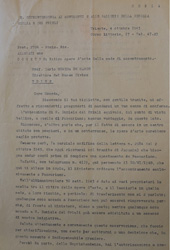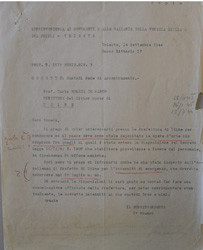After September 8, 1943, the situation changed drastically. Part of Friuli, Venezia Giulia, Istria and part of Slovenia, as well as Fiume, were included in the III Reich. The custody of artworks in one sole location was turning out to be ever more dangerous, when faced with the risk of requisitions and confiscation by the German militia.
“Bisogna di proprio criterio agire se si vuol salvare quanto interessa la nazione” (10 settembre 1943).
Someda de Marco took on the responsibility of undoing the centralization. When possible, the artworks were returned to their rightful owners, while the remaining ones were transferred partly to the cellars of the Castle of Udine, partly to San Daniele del Friuli, in locations belonging to #princess Windisch Florio and Mrs. Pirona widow Mjliani.
In these storages, a constant inspection of the works of art was carried on, but their exact location was bravely kept a secret from the German authorities.
In February 1944 Someda de Marco was sent for by German Ministerial Advisor Pfeifer, who demanded the delivery of the artworks in his custody in order to furnishing offices of the SS and of the German Police in Udine. Someda de Marco was adamant in protecting the cultural heritage at whatever cost, well aware that if artworks had left his custody, they would have been lost.
Someda de Marco was able to fool the German police again in June 1944, when, with the support of Umberto Piazzo, he managed to close all doors to the storages in San Daniele with protective walls, leaving only slits for the air flow. The help of the Captain of the Carabinieri of Udine, Ottavio Fattorini, was vital, for it was he who was able to throw off German suspicions with “adequate expedients”.
These events were noted in an Allied report, dated August 2, 1945 “on German Activities 1943-5 in the Operationszone Adriatisches Küstenland in the Field of Fine Arts, Libraries and Archives”.
“The Italian Superintendency had followed the practice of other Superintendencies in moving the great bulk of the best movable works of art away from important centres to places of safety. The majority of those from UDINE and VENEZIA GIULIA was in various localities in UDINE, but some had already gone to VENICE. Dr. FRODL states that this was a matter which was left very much to the Italians themselves; and the Superintendent, Dr. Franco, helped to keep them in the dark by frequent and unannounced changes of location. The only open cause for disagreement arose over the frequently and forcibly expressed wish of FRANCO to remove some of the more exposed deposits in UDINE down to VENICE. This was turned down flatly by the Oberste Kommissar, a decision which was approved by both HUBER and FRODL, both of whom allege that the dangers of road-transport were then too serious. It should be noted that precisely the opposite reasoning was advanced in the cases of the CASTEL DUINO Library and of the Archivio Morelliano at GORIZIA, and the suspicion of a more sinister motive was certainly present in Italian minds.”
(London, Public Record Office, WO 204/2992)
Only the polyptych of Krk by Paolo Veneziano was surrendered to the German authorities, under pressure by the archbishop of the island, Josip Srebrni?, in turn supported by the Supreme Commissioner for the Adriatic Littoral. To prevent the Nazis from becoming aware of the secret locations in San Daniele, the Italian authorities transferred the painting to another site (the vicarage of S. Tomaso in Majano). In the pages of his Journal, Someda feels compelled to clarify that he “did not deliver the artwork, but was witness to its withdrawal”, underlining his disapproval.
This event also finds place in an Allied report dated August 1945 “on German Activities 1943-5 in the Operationszone Adriatisches Küstenland in the Field of Fine Arts, Libraries and Archives”.
“The Abteilung Denkmalschutz was directly concerned in the return to the Bishop of KRK of the fine medieval painted altar-frontal of the church of Santa Lucia di Giurandor in the Island of VEGLIA. This picture was seized by the Italians in the 1918 as recompense for the transfer to LJUBLJANA by the Austrians of some 200 Tiepolo drawings, which are now safely housed once more in the Museo Civico. They were reluctant however to return the Pala, on the alleged ground of war-risk. The Bishop of KRK thereupon approached the Oberste Kommisar direct; and on his orders through HUBER to Dr. HANFSTAENGL, the Pala was taken from its deposit and formally handed over to the Bishop´s representative on 28 Oct 44. There is no news of its subsequent fate.”
It was probably because of this state of secrecy that we have no photographs of San Daniele deposits.



